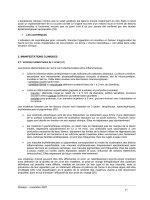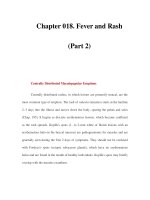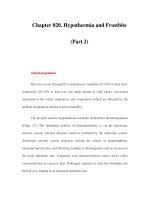How To End Phobias, Anxiety & Panic - part 2 pot
Bạn đang xem bản rút gọn của tài liệu. Xem và tải ngay bản đầy đủ của tài liệu tại đây (151.26 KB, 10 trang )
For example, “If I enter the swimming pool I’ll faint and
drown. Probably the chlorine in the water is poisonous and in
any case the water’s bound to be too hot [too cold, too crowded,
too deep . . .”].
Such irrational thoughts are replaced in therapy by rational
thoughts. The more positive, the better. For example,
“I’ve swum safely in the pool before.
There is an alert lifeguard.
I am an excellent swimmer.”
The most widespread phobia is fear of public speaking.
Perhaps this phobia is so common because most of us are
brought up to blend in, to conform. When called upon to give a
speech, we are thrust into the limelight: perhaps we will not
measure up, perhaps we won’t be liked!
Most people who endure a phobia unwittingly help to keep it
alive by filling their minds with negative “what ifs.”
It’s important to remove these negative “what if?” thoughts that
feed anxiety and panic.
Why not change them to positive “what ifs”!
Instead of “what if the plane crashes” to “what if the plane
arrives safely”.
Instead of “what if they laugh at me” to “what if they love my
speech.”
Instead of “what if I drown” to “what if I learn to swim.”
A social phobic who lacks self-confidence could benefit from
the Psychovisual Therapy hypnotic video called, (what else?)
“Self-Confidence.”
10
The video provides information on conscious and subconscious
levels. It can make the difference for a social phobic eager to
conquer his or her irrational fear.
Because, ultimately, the solution to social phobia is to face the
fear.
Doing so brings immense rewards. I can barely begin to
describe the pleasure I now enjoy when giving a public talk.
It’s so fantastic to stand in front of a crowd, impart useful
information to them, have a few laughs, and learn from the
questions and comments of the audience.
I vividly remember the first time this happened. I was
scheduled to give a speech at a large convention of hypnotists
in the U.S. There were a dozen or so competing seminars
offered at the same time so I thought probably 6 or so
hypnotists would choose my session.
When I located the room in which I was to speak I had to fight
my way in, there were so many people trying to enter. To my
amazement, not only was the room packed with hypnotists, (I
stopped counting at 103) but video cameras had been installed!
Well, I used the advice on the “Self-Confidence” video, took a
slow deep breath, and on breathing out, said, “This is easy.”
And it was!
Since then I’ve given talks wherever and whenever I can. So I
know that social phobia can be beaten! As the cliché has it: if I
can do it, so can you.
11
Purposeful Phobias
These are paradoxical. Their purpose is to divert attention from
a psychological conflict within a person. Yet their presence is a
clear sign that conflict exists.
The inner conflict may or may not be consciously known to the
sufferer.
The phobia acts as a diversion.
While you concentrate on your fear of whatever, you are
diverted from something else which some part of you considers
too terrifying to look at.
Purposeful phobias often are mechanisms to avoid issues of
betrayal,
abandonment,
non-acceptance.
Unlike purposeless phobias, there are often secondary gains
for the phobic. These commonly involve
attention,
exemption, and
control.
Attention to the phobic (“poor little Jamie; he doesn’t feel well
enough to go to school, let’s tuck him up in bed and give him
his favourite candy”) brings the secondary reward of comfort,
of being the centre of consideration.
Exemption brings secondary rewards of freedom from
responsibility (“Be nice to Harry; you know he doesn’t drive,
why can’t you give him a ride, it’s only a few blocks out of
your way”).
Control is the key to the cause and the conquering of phobias.
Phobia sufferers display:
12
fear of loss of control,
control of other people through helplessness,
control of overt fear through avoidance,
control of deeper fear or inner conflict.
Control by Jamie and Harry is partly conscious, partly
subconscious. They enjoy control of family members, as
demonstrated by the attention and exemption.
At the same time they exercise a degree of control over their
fear (of school, or of driving).
In addition, there is the subconscious control over whatever is
being avoided by the focus on the phobia.
Sometimes the feared situation has an element within it which
provided the seed of fear; more often the feared situation has no
discernible roots to the deeper, avoided fear.
Jamie, for instance, may be terrified of leaving home, and
Mom: if he goes to school perhaps that means Mom wants to be
rid of him, maybe she won’t be there when he comes home. So
it is not school which scares Jamie; it’s being abandoned by
Mom.
Likewise, Harry may be scared of independence, of all that is
symbolised in our society by the automobile. It may seem safer
to Harry to avoid the test of being grown up.
Both Jamie and Harry, of course, are unaware of these
underground emotions: their conscious minds are aware only of
their respective fear of school and disinterest in driving.
Boston resident Pamela wanted to fly with her husband to
Europe. He made frequent business trips to Belgium and always
invited her to accompany him.
But she was too scared. Pamela was also frightened to ride in an
elevator, or to go to the local mall alone.
13
She even found it hard to go into her own back garden. Her
little son and daughter, and of course, her husband, tolerated
Pamela’s fears but family tensions were rising.
Since the family lived in a quiet suburb this meant someone had
to drive her, or accompany her on the rare public bus, wherever
she needed to go.
It also meant that unless Phil, her husband, was available to go
with her, she never attended school functions. Raised as a
devout churchgoer, Pamela now rarely went to church.
She spoke in a whispery voice, stood with rounded shoulders
and downcast eyes.
When she began hypnotherapy Pamela barely spoke. She did
manage to say that she was afraid Phil would get tired of her
phobias, and leave.
Pamela couldn’t understand why he’d stuck around as long as
he had.
Their honeymoon had been a disaster: because of her phobias
they’d driven to a lake resort 400 miles away, rather than flown
to Hawaii, Phil’s first choice.
But no sooner had they arrived than Pamela was filled with
dread and insisted Phil immediately drive back.
Now it was nine years later. Nothing had improved. Although
she dearly loved her children both births had been terrifying
ordeals for Pamela.
Phil brought her to a psychotherapist. Pamela told him how
fearful she was and how annoyed she was with herself,
especially about being too fearful to travel. “And my father is a
long-distance truck driver.”
That was the first clue for the therapist. When Pamela described
the rest of her family of origin, the underlying conflicts became
transparent.
Her brother shared similar fears. Both only felt really safe and
relaxed when with their mother.
14
The mother was practically house-bound, and very bitter.
Pamela’s father, the truck driver, had never been faithful, was
rarely in town, let alone at home.
Pamela and her brother grew up feeling a heavy responsibility
for their mother, who was subject to fits of hysteria and panic.
They also felt resentment and hostility toward their absent
father.
Sure enough, when the therapist employed hypnosis to examine
the origins of Pamela’s fears, concern for her mother was
paramount.
Like the over-responsible little girl she still was inside, Pamela
could only feel safe when she knew her mother was safe.
But at the same time, Pamela deeply resented this
responsibility. There was an invisible string connecting Pamela
to her mother. She was the yo-yo being yanked back whenever
the mother chose.
Rational-Emotive Therapy (an approach that teaches how to
use your thoughts to control your feelings) was used in and
outside of hypnosis to help Pamela clarify her thinking.
Hypnotherapy was also used to strengthen Pamela’s resolve, to
build her self-confidence, and to enable her to conquer her
phobias one by one.
The first significant sign of progress was when Pamela
appeared on her own in the therapist’s office.
“I took the elevator by myself,” she announced proudly. From
then on, small steps multiplied.
Pamela began to walk to the mall alone. She asserted herself
with her mother. She took the bus alone, or with the children.
She took driving lessons.
For each of these steps appropriate hypnotherapy gave her the
confidence to draw upon the resources that for so long had lain
dormant within her.
When Pamela passed the driving test Phil gave her a car as a
reward. Then the therapist worked with her to help Pamela
overcome her fear of driving across bridges.
15
One evening she arrived eager to report that she had not only
driven, fear-free, across a bridge but across the worst one in the
area: a noisy, ramshackle former railroad span.
Phil and Pamela took a practice flight to a city an hour’s flying
time away. Again (following the enjoyable imagined experience
in hypnosis and post-hypnotic suggestions) Pamela felt again
the wonderfully pleasant surge of accomplishment.
She was no longer trapped by underlying guilt about
abandoning her mother and hating her father.
A few months later, the psychotherapist responded to a knock
on his door. When he opened it there stood a glamorous
woman, head high, grin great, posture upright, handshake firm,
voice strong. Pamela!
The therapist had not recognized her, so changed was she from
the mousy, fear-ridden person who’d come for help the year
before.
16
“Just having a panic attack”
A client wrote:
“I’m terrified something awful is happening to me. Almost
every day I become really scared. I shiver, my chest hurts, my
throat goes dry, I feel dizzy, faint and frightened for fifteen or
twenty minutes of hell. When this happens I feel sure I’m going
insane, or I’m going to die. My doctor says there’s nothing
wrong, that I’m “just” having a panic attack.
She wouldn’t be so complacent if this happened to her! How
can this be ‘just in my head’?”
The pharmaceutical companies would like you to believe that
panic attacks arise from something biological … and therefore
can be fixed with a pill.
But if a “chemical imbalance” triggers your panic attack, what
triggers the “chemical imbalance”?
And if you are continually imbalanced chemically, then why are
you not suffering continuous panic?
The reason is, of course, that the panic attack gives rise to the
chemical imbalance, not the other way around. And the surge of
chemicals subsides. So what is it that brings on an attack?
Almost anything. Yet something which is significant to your
subconscious.
This may be a thought, a smell, a sight or a sensation (e.g., the
touch of velvet which triggers a subconscious memory of
feeling abandoned at age four when your velvet-clad mother
accidentally left you behind for an hour in the church at Aunt
Susanna’s wedding).
Once the cue has been thought, smelled, seen, touched, tasted or
heard, your body reacts. It automatically replays the emotions
you experienced the first time.
17
Although you do not necessarily consciously remember feeling
abandoned (for example) the fear is stored in your
subconscious.
Your body has its own storehouse of memories. When a
particular negative experience is thus recalled, the autonomic
response of the body is also recalled. This is the adrenaline
rush.
Our bodies have a built-in reflex that served our ancestors well.
Whenever they were faced with danger—a sabre-toothed tiger
about to spring on them, or an avalanche bearing down—their
bodies would automatically prepare to run or to fight.
All temporarily unneeded bodily functions would shut down.
Energy would be concentrated where it was most needed.
Adrenaline would be pumped swiftly to increase the heart rate
which in turn caused the lungs to gulp more air as the legs
tensed for running away or the arms tensed to do battle.
We still have this automatic response to danger. But instead of
tigers, we fear rejection, embarrassment, failure, shame,
disappointment, etc. And we neither fight nor run.
However, as we stay still, anxiety causes that rush of adrenaline
which in turn causes us to
breathe rapidly,
tense our muscles,
increase our heart rate, and
feel sick to out stomachs.
In other words, we panic.
A panic attack is often your body’s way of sending an urgent
signal that something in your life needs to be fixed. Like
phobias, the cause may be conscious or subconscious.
Since the symptoms resemble organic illnesses, it is of course
sensible to have a medical check-up to make sure your chest
18
pains are not a sign of heart trouble, or your sweaty palms a
sign of a thyroid disorder.
Involuntary shaking, shivering and light-headedness might be
signs of a neurological problem — or a result of ingesting too
much caffeine.
But if medical causes are ruled out, then your panic attack
points to an emotional or psychological issue. Undealt with, the
attacks usually multiply in frequency and intensity.
The unpredictable timing of panic attacks leads to a fear of fear.
A panic attack is absolutely dreadful.
Someone who has not experienced the
terror cannot understand.
When a panic attack strikes you feel
sure you are going to die, or go insane.
If your first panic attack strikes you in a shopping mall the fear
of being embarrassed and humiliated by another attack may
cause you to avoid that mall.
Then you begin to fear that an attack may hit you if you go to a
different mall, so you avoid that, too.
If you subsequently suffer an attack in an independent fruit
store you’ll avoid that shop in future but perhaps you’ll also
start to fear any shop that sells fruit, for fear of another attack
hitting you.
Eventually you could end up trapped at home, afraid to venture
anywhere, just in case.
19









